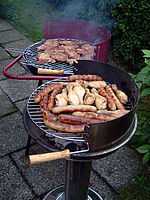Pork ribs
From Wikipedia, the free encyclopedia

Balinese roasted pork ribs
Pork ribs are a cut of pork popular in North American and Asian cuisines. The ribcage of a domestic pig, meat and bones together, is cut into usable pieces, prepared by smoking, grilling, or baking – usually with a sauce, often barbecue – and then served.
Cuts of pork ribs
Several different types of ribs are available, depending on the section of rib cage from which they are cut. Variation in the thickness of the meat and bone, as well as levels of fat in each cut, can alter the flavor and texture of the prepared dish. The inner surface of the rib cage is covered by a layer of connective tissue (pleura) that is difficult to cook tender; it is usually removed before marinating or cooking.
Baby ribs

Roasted baby back pork ribs
- Baby back ribs (or loin ribs, back ribs) are taken from the top of the rib cage between the spine and the spare ribs, below the loin muscle. The designation "baby" indicates the cuts are from market-weight hogs (240–270 lbs.), rather than adult hogs (500–650 lbs.). They have meat between the bones and on top of the bones, and are shorter, curved, and sometimes meatier than spare ribs. The rack is shorter at one end, due to the natural tapering of a pig's rib cage. The shortest bones are typically only about 3 in (7.6 cm) and the longest is usually about 6 in (15 cm), depending on the size of the hog. A pig side has 15 to 16 ribs (depending on the breed), but usually two or three are left on the shoulder when it is separated from the loin. So, a rack of back ribs contains a minimum of eight ribs (some may be trimmed if damaged), but can include up to 13 ribs, depending on how it has been prepared by the butcher. A typical commercial rack has 10–13 bones. If fewer than 10 bones are present, butchers call them "cheater racks".
Spare ribs

Pork spare ribs, uncooked

Spare ribs cut into riblets with Chinese barbecue sauce
Main article: Spare ribs
- Spare ribs, also called "spareribs" or "side ribs", are taken from the belly side of the rib cage, below the section of back ribs and above the sternum (breast bone). Spare ribs are flatter and contain more bone than meat, but more fat can make the ribs more tender than back ribs. The origin of the name "spare ribs" is not certain, but could be related to the spare amount of meat after the belly is removed.
- St. Louis style ribs (or St. Louis cut spare ribs) have had the sternum bone, cartilage, and rib tips (see below) removed. The shape is almost rectangular.
- Kansas City style ribs are trimmed even more closely than the St. Louis style ribs, and have the hard bone removed.
Rib tips
- Rib tips are short, meaty sections of rib attached to the lower end of the spare ribs, between the ribs and the sternum. Unlike back ribs or spare ribs, the structure of the rib is provided by dense costal cartilage, not bone. Rib tips are cut away from the spare ribs when preparing St. Louis style spare ribs.
Other cuts and preparations

Barbecue country style pork ribs

Smoked country style pork ribs
- Button ribs are flat, circular-shaped bones located at the sirloin end of the loin. They are not actually ribs, as they are not taken from the rib cage. The button ribs consist of the last four to six bones on the backbone; they do not have actual ribs connected to them. The meat on the button ribs consists of meat that covers each button and connects them together.
- Country-style ribs are cut from the blade end of the loin close to the pork shoulder. They are meatier than other rib cuts. They contain no rib bones, but are instead contain parts of the shoulder blade (scapula).
- Rib roast (or bone-in pork loin rib roast, bone-in loin rib roast, center cut rib roast, prime rib of pork, standing rib roast) is a whole pork loin with the back ribs attached. They can be up to 2 ft long and 6 in thick. They are sold whole or in sections.
- Rib chops are pork steaks or chops that include a back rib bone and the loin meat attached. They are lean and tender.
- Riblets are prepared by butchers by cutting a full set of spare ribs approximately in half. This produces a set of short, flat ribs where the curved part of the rib is removed. Another product (imprecisely) called riblets is actually the transverse processes of the lumbar vertebrae.
- Rib patties – The meat from the ribs is taken off the bone and ground to make rib patties. McDonald's McRib patties contain pork meat mostly from non-rib sections of the hog.
- Christmas ribs – About half of Norwegian families eat oven-cooked rib at Christmas Eve.[1] Normally, they are referred to as ribbe or juleribbe. Traditional recipes include steaming half an hour before cooking in the oven to achieve a crisp surface.[2]
See also
- Ribs (food)
- Galbi
- Rack of lamb
-
 Food portal
Food portal
References
External links
![]() Media related to Pork ribs at Wikimedia Commons
Media related to Pork ribs at Wikimedia Commons
| ||||||||||||||||||||||||||||||||
This article is issued from Wikipedia. The text is available under the Creative Commons Attribution/Share Alike; additional terms may apply for the media files.
